SINOVATE, a collaborative technology company recently revealed its new Peer-to-Peer (P2P) digital currency called SIN. Through the creation of unique and modern Blockchain products, services and solutions like Infinity Nodes, the team at SINOVATE encourages community growth while paving the way towards mass adoption of cryptocurrency. SINOVATE implements a decentralised solution by harnessing existing technologies and concepts, innovating them and creating multiple features that give users the ability to adopt new technology in a secure environment. Transition from SUQA to SINOVATE was briefly delayed due to minor bugs identified within the Mainnet Wallet. These have now been successfully resolved, with functionality back at 100%. The SINOVATE Hard Fork officially went live on 1st June 2019 at approximately 09:00 UTC, and comes equipped with a wide range of enhancements and features to be discussed in this article.
SIN, the successor of SUQA coin combines its brand new X25X Proof of Work (PoW) algorithm with Komodo’s unique security mechanism, known as Delayed Proof of Work (dPoW). X25X is CPU as well as GPU mineable and ensures ASIC, FPGA and quantum resistance. SWIFFTX is also added to the algorithm chain, with increased ram usage per nonce utilised for FPGA devices. This ensures decentralisation is maintained at all times. dPoW provides an additional security layer, further safeguarding the SINOVATE Blockchain against 51% attacks by leveraging the hash rate of the Bitcoin network, in a clever process known as notarization. dPoW will be integrated into the SINOVATE Network during July 2019.

A node is a vital part of the big picture, and can be described as a computational wallet, which works to ensure the integrity of a network. In this case, the network is that of a well maintained cryptocurrency.
Cryptocurrencies are dispersed by its users, usually in a decentralised system -unlike centralised banks. In order to be fully operational and to be distributed effectively, nodes need to run from multiple geographic locations to reinforce the network, while hosting a replicated Blockchain.
A Masternode, much like a node, supports and helps a cryptocurrency network through the form of a computational wallet. A Blockchain is replicated by the node owner, who is compensated for using their resources via crypto coins. In essence, Masternodes serve as a profitable alternative to earning cryptocurrency via mining.
The concept of a Masternode has been widely deployed as a useful way to support a network while adding incentives to “hodl” the coins they support -but there is always the unintended consequence of high inflation and emission.
Infinity Nodes are a new invention within the crypto sphere. These innovative Proof-of-Service protocols improve the current Time-Lock feature, by enabling node owners to take advantage of a unique reward system.
Distinct in their capability, Infinity Nodes hold the maximum capacity required to host comprehensively more nodes than any other cryptocurrency. Full nodes ensure that the highly scalable SINOVATE Blockchain, in tandem with dPoW will provide a swift, secure and seamless networking experience at all times.

SINOVATE is proud to pioneer this groundbreaking technology, which successfully provides passive, annual income while concurrently decreasing inflation. Infinity Nodes are the evolution of Masternodes, and aim to revolutionise financial interest systems. Typically, Masternode, Proof of Stake (POS) and even PoW cryptocurrencies fail to address the obstacles involving high inflation and emission, leading to deflation of value.
In order to control these factors, SINOVATE coins used to create nodes will be burnt immediately. The Infinity Node system entirely removes coins from the SINOVATE Blockchain, handsomely rewarding owners with, for instance a guaranteed minimum annual interest of around 22% (594 million SIN need to be locked into Infinity Nodes for this to happen). Significant scarcity of SIN coins will be created at the same time.
Infinity Nodes are available in three tiers, known as Little SIN (100,000 SINOVATE), Mid SIN (500,000 SINOVATE for an additional 5% bonus) and Big SIN (1,000,000 SINOVATE for a sizeable 10% bonus). Nodes require 10,000 SINOVATE collateral in order to operate, which is wallet-locked for their entire 12 month lifespan. Should the collateral amount be unlocked prior to maturation, Infinity Nodes will no longer function and generate rewards.
Infinity Nodes enable the instantaneous transfer of SIN coins, carried out through FlashSend. At the time of writing, the SINOVATE network permits 533 transactions per second (tps), making it 75 times more scalable than Bitcoin. Total network transactions are burnt, following the implementation of the current Hard Fork, further lowering inflation and emission. Ordinarily, standard SIN transactions require 6 confirmations. A standard 1 Megabyte (MB) block can contain a maximum of 4000 transactions. With a block every 2 minutes, SIN has 16 times this capacity, which can be validated by the following equation:
- 4000 * 16 / 120 = 533.33
At less than three seconds, FlashSend has one of if not the fastest total transaction speeds within the crypto space. This is aided further by reducing confirmations to minimum levels, provided by shielded protection from dPoW. Due to the rapid nature of transfers, integrating additional use cases such as micro and mobile payments will be seamless.

Users also have the option to transfer their SINOVATE coins anonymously, via a feature known as ShadowSend. ShadowSend provides true financial privacy by obscuring the origin of your funds. All stored SIN is comprised of different inputs, which can be treated as separate, discrete coins. ShadowSend uses an innovative method to mix these inputs set to 5 rounds by default, without coins ever leaving your wallet. This ensures control of funds is always retained. FlashSend and ShadowSend functionality coincided with the current Hard Fork.

In addition, Infinity Nodes contain an enhanced E-Governance system designed to put power in the hands of its users, through the form of decentralised revolving votes. Revolving Sovereignty Votes (RSV) will replace the traditional voting system, and will be dependent on the 12 month lifespan of nodes. RSV will be integrated during the next Hard Fork, which takes place in late 2019.

Incorruptible Data Storage (IDS) is a revolutionary Private Networking mechanism, designed to allow users to send encrypted files to one another anonymously. User security is of paramount importance, which is permitted through preservation and resilience from the Bitcoin, Komodo and SINOVATE Blockchains. Transaction fees will be burnt from the circulating supply, and are determined by file sizes (initially limited to 1.5 MB each). Ultimately, the goal is to achieve unlimited decentralised data transfer and storage, which will be implemented in a five stage process. IDS provides the following unique benefits:
- Increased security of personal information held by multiple industries and establishments, including Finance, Medicine, Insurance and Government records.
- Data control back in the hands of users and recipients, with no additional storage costs.
- No more prying eyes — Think Facebook, Google and Yahoo data hacks.
- Alleviation of hacking and power outage disruptions centralised databases are prone to experience.
Blockchain serves as a public ledger used to record all network transactions via a decentralised data log, as opposed to a physical ledger or single database. While Blockchain technology was originally created as an alternative spending mechanism to traditional currencies, use cases have since diversified across a multitude of different areas, including but not limited to file storage (as described above), identity management, financial exchanges, medical records management and education.
For all of its benefits, modern technology also presents a number of threats, with fraudulent activities, including the creation of counterfeit documents rife within society today. Distinguishing between what is genuine and fabricated has become an increasingly cumbersome task for the layman, merchants and service providers alike.
SINOVATE aims to counter this threat via a feature known as SINOVATE Document Verification (SDV), which will use Blockchain Technology to digitally verify the authenticity of documents, including Birth Certificates, Passports and Insurance details. SINOVATE Document Verification will work in tandem with IDS, providing users with a trustworthy and secure system to appreciate.
IDS and SDV integration will commence during the first quarter of 2020.

Unlike traditional Masternodes, Infinity Nodes and the coins locked within them will be removed from the circulating SIN supply, while still continuing to support, validate and secure the network. This means that those who operate an Infinity Node will collect their incentives for “hodling”, consistently over a full year. At the end of the Infinity Node’s locked up year, they are then burnt forever.
Similar to conventional Masternodes, rewards are not distributed via a Ring Signature procedure and are instead calculated by average. For each individual block, the X25X algorithm finds the top 30 nodes spanning across each Infinity Node tier. One Big, Mid and Little SIN Node must be found within this list, in order to initiate the reward process. For instance, should no Mid SIN Infinity Node be found, all rewards relating to that block will be undistributed and permanently burnt.
- The incentive rate received is dependent on the number of locked in Infinity Nodes.
- In the event that the node limit is exceeded, return on SIN coins will be received within the first 300 out of 365 days.
- Where the circulating supply of 645 million minus 20 million from the Development Wallet is reached (for the sake of transparency and fairness, this will not be locked into Infinity Nodes), the maximum quantity of SIN coins locked into Infinity Nodes will be 594 million. In this instance, the existing circulating supply will be 31 million, to be used for trading and using SINOVATE. Also, if the maximum cap is reached in a shorter period, the total supply will have decreased by 30 times.
- All Infinity Nodes have a theoretical shelf life of 12 months, at which point they will be removed from the node count.
- Significant annual interest with minimal emission to the coin supply will be received by Infinity Node holders, after the initial coin lock.
- Node payments will be received every day for the duration of one year, providing a 24/7 uptake is maintained.
Infinity Nodes will also implement the Proof of Burn (POB) mechanism, which by definition provides Blockchain network validity by ensuring that all participating nodes reach consensus. In SINOVATE’s case, POB will secure the network still further, by forcing bad actors to think twice before attempting to carry out malicious activities. This is because SIN coins must be sent to an unspendable address, in order to initiate the burn process.
As previously explained, Infinity Nodes have an operational lifespan of 12 months, and must remain active for this entire duration to enable sustained network stability. POB will provide this stability for future use cases such as IDS, as a decreasing circulating supply will significantly lower sell pressure on investors and increase the value of their holdings, creating an all round beneficial environment.
SIN Nodes can be obtained by mining and trading SINOVATE coins. The SINOVATE Foundation is committed to decentralisation and fair opportunity for all. Infinity Nodes will be distributed and rewarded as follows:
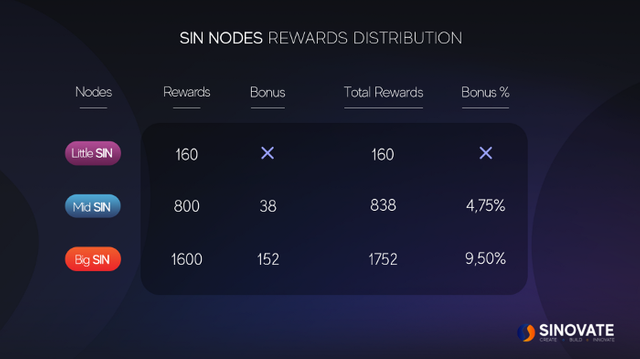
20 million SIN remaining from Development Wallet expenditures will not be used to acquire Infinity Nodes under any circumstances.
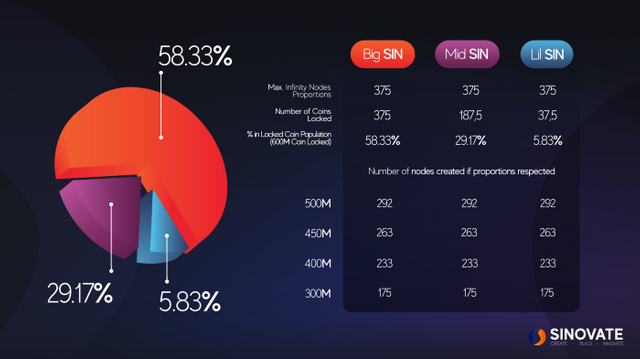
Return on Investment is dependent on the quantity of locked in nodes as well a decreasing circulating supply, which is shown in the diagram below:
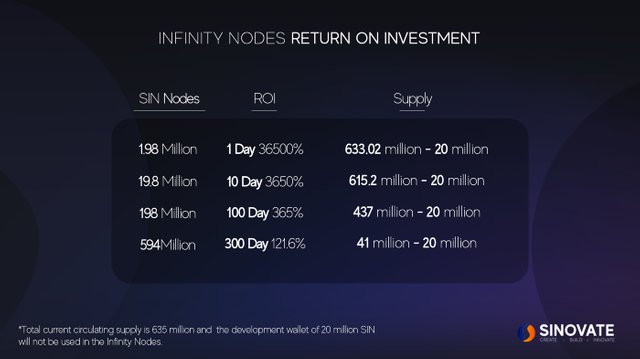
“Decreasing block rewards over time is a traditional means of creating scarcity in a cryptocurrency. Unfortunately, miners lose out in this scenario. Understandably, they feel aggrieved that their hard earned resources fail to offer the returns they desire. Added to this is the fact that lower transaction fees only serve to drop the overall hash rate, which presents an entirely new danger. The likelihood of a 51% attack taking place on a network is manifested. The advent of Infinity Nodes and dPOW no longer makes this a possibility. Energy costs substantially decrease, meaning miners continue to benefit and reap in rewards. We wanted to continue giving back to the people who believe in us and what we stand for long term. Infinity Nodes, through constant hard work and dedication from the brilliantly talented SINOVATE Team has made this a reality”.
Tamer Dagli, SINOVATE CEO and Founder.
- Block Time: 2 minutes
- Max Block Size: 16MB
- Max Transactions Per Second: 533 tx/s
Total supply will be approximately 2.5 billion SIN after 20 years, which includes all SINOVATE Blockchain, IDS, RSV, assets and future technology transaction fees, which will all be burnt immediately from the circulating supply.
Mining as well as Infinity Node rewards will be distributed as follows:
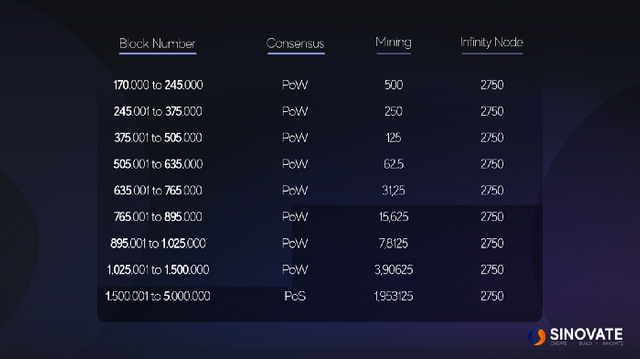
The Public Infinity Node Testnet period commenced on 15th April 2019, and brought to light a number of issues within the functionality of Infinity Nodes. With the help of SINOVATE’s fantastic community, these have all been identified and successfully resolved. The SINOVATE Final Mainnet Wallet has been released, and contains fixes to all bugs identified during the Public Testnet phase.
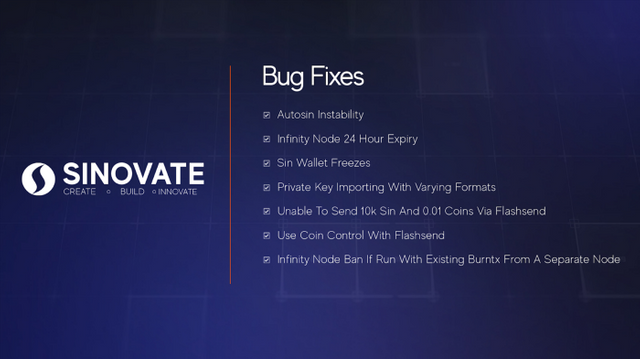
Upgrading to the Mainnet Wallet prior to the Hard Fork was a mandatory requirement:

The Public Infinity Node Testnet period ended on 1st June 2019. Infinity Node implementation swiftly followed, also on 1st June 2019. Additionally, SINOVATE’s community had the opportunity to thoroughly test the X25X algorithm on their machines, prior to officially going live:
Join us and stay tuned for all forthcoming updates via our website and social media platforms: